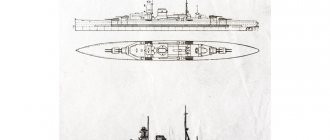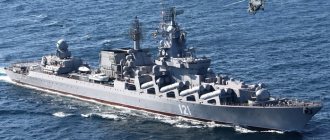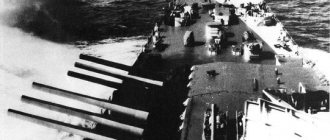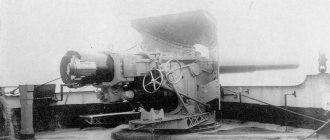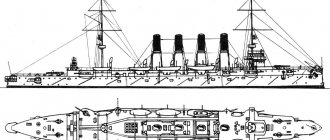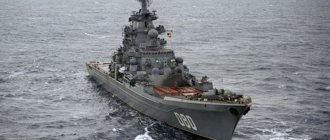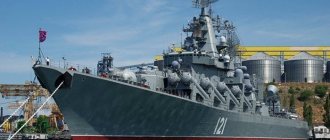The best cruiser of the Port Arthur squadron
The armored cruiser Bayan, built in France, was a new type of ship for the Russian fleet - an armored reconnaissance unit attached to a squadron, and not an autonomous raider, like previous combat units of this class. Despite not the most optimal tactical and technical characteristics, Bayan showed itself superbly during the Russo-Japanese War, becoming the best cruiser of the Port Arthur squadron.
The expansion of the Russian Empire in the Far East led to an inevitable clash with Japan, which had already tasted victory over China. In preparation for the upcoming war, Russia began to urgently strengthen its forces in the Pacific Ocean. The main focus was on linear forces - according to the shipbuilding program of 1898 (later combined with the program of 1895), Russia was supposed to have a fleet of 10 squadron battleships in the Pacific Ocean.
For successful operations, the main forces needed scouts attached to the squadron. Initially, armored cruisers of the 1st and 2nd ranks were proposed for this role (as long-range and short-range reconnaissance ships, respectively), but the lack of side armor and artillery protection made them unsuitable for combat with a strong enemy. The Russian fleet also had large armored cruisers (“Rurik” and “Russia”), however, they were not suitable for the role of scouts for the squadron, being practically “pure” raiders. In turn, a ship intended for service with a squadron of battleships had to have such weapons and protection as to be able to fend for itself in battle with enemy light forces, without much fear, get close to the main forces of the enemy, and, if necessary, take a place in the line of their ships for squadron battle.
In April 1897, four projects of French armored cruisers were submitted to the Marine Technical Committee (MTK) for consideration, which were supposed to be used as prototypes. None of these projects satisfied the MTK, but the basic requirements for the future cruiser were developed:
- displacement no more than 6,700 tons (however, it was allowed to increase the displacement to 7,000 tons if the project was considered successful);
- the body must be lined with wood, copper and have a double bottom;
- coal reserve for 7000–8000 miles of economical sailing, maximum speed - at least 21 knots for 24 hours;
- a two-shaft power plant with Belleville boilers (the mandatory use of economizers was specifically stipulated);
- mandatory onboard and carapace reservations;
- armament of two new 203 mm guns, eight or ten 152 mm Kane guns and twenty 75 guns, not counting smaller artillery; all main-caliber artillery and part of the 75-mm guns had to be protected by armor.
As can be seen from these requirements, the MTK decided to create a better protected and armed ship within the displacement of the Diana-class armored cruiser. Due to the urgency of the order and the workload of domestic shipyards, they decided to build the cruiser abroad. The question of where to build the ship did not even arise - close ties had long been established between French shipbuilding firms and Grand Duke Alexei Alexandrovich, who held the post of chief commander of the fleet and the Maritime Department. Since there was no ready-made project in Russia, the competition task was sent to French shipbuilding firms, which sent their drawings six months later. A total of three projects were sent: from the Toulon and Le Havre branches, as well as from. The project from Toulon by engineer Antoine Lagan was recognized as the best (even despite the fact that the ship's displacement reached 7800 tons). As a result, after a number of changes, in June 1898, a contract was signed with Lagan for the construction of an armored cruiser in Toulon - the future Bayan.
Brief description of the ship
The tactical and technical characteristics of the ship are given in the table at the end of the article; here we note only some of the features of the French project. The main belt of the ship had a very significant thickness in the middle part (200 mm), but at the same time it was very narrow - only 60 cm rose above the water. But the upper belt, 60 mm thick (on a backing of two layers of shipbuilding steel 10 mm each) had 2, 3 m in height, covering a significant part of the side with armor. The gun casemates were also protected by 60 mm armor. Thus, the armor protection area was even higher than that of the Japanese Asama-class armored cruisers. The armored deck of the cruiser was flat, adjacent to the upper edge of the main armor belt and did not have bevels typical of shipbuilding of that time.
In general, the level of the ship’s protection should be considered sufficient to combat “classmates”, however, it had several weak points. Firstly, the chimneys were not protected, and the boiler rooms were not covered from above with armored grates - later this feature did the ship a disservice when during the battle several boilers failed due to shell fragments exploding from above. Secondly, the barbette of the bow tower below the armored deck was only 50 mm thick, being covered by side armor only 80 mm thick. Thirdly, part of the hull in the stern was not covered with waist armor at all, which made the steering compartment vulnerable. The cruiser also had poor protection from mounted hits - the thickness of the roofs of the artillery towers, casemates and conning tower was clearly insufficient. To justify this, it can be noted that at that time it was unlikely that artillery duels at long distances were expected, moreover, the main opponents of the Bayan - armored cruisers of the Asama class - also had holes in their defense.
Bayan reservation scheme. Reconstruction by S. E. Vinogradov Source: tsushima.su
The Bayan steam engines were unified with the engines of the squadron battleship Tsesarevich, which was being built at the same time - thus, it was possible to reduce their cost.
The placement of the main caliber artillery on the Bayan was different from all Russian ships, but was typical for the French fleet. 203-mm guns with a barrel length of 45 calibers were placed in single-gun turrets at the ends of the ship. The axes of the guns (especially the bow one) ran high from the waterline, which guaranteed the possibility of firing in fresh weather. Alas, the same cannot be said about casemate guns, which were located low above the water, which made their use in fresh weather difficult or even impossible.
Construction and testing
The contract for the construction of the cruiser was signed on June 25, 1898 - the cost of the ship without weapons was 6.1 million rubles. Construction began in November, the official laying took place on June 26, 1899, simultaneously with the battleship Tsesarevich, which was being built on a neighboring slipway. Supervising the construction of the ships on behalf of the Russian side was Captain 1st Rank I.K. Grigorovich (future Minister of the Navy). At first, construction proceeded quickly, but delays soon arose - the main reason for this was the actual disruption of the supply of side and turret armor and the Chatillon-Commentry. In addition, the supplied armor turned out to be of poor quality and often did not pass acceptance tests. As a result, it was necessary to change the armor supplier, and the last plates for the aft turret were received from the factory only in September 1902.
The hull was launched on May 30, 1900 - the cruiser launched without propellers, the castings of which were rejected due to numerous shells and non-compliance with the drawings. The production of the main mechanisms also proceeded with difficulty - crankshafts, pistons, and other parts were rejected more than once. The quality of work at French shipyards is evidenced by the fact that the frame of the right car did not fit its foundation and was returned for modification. Despite all the obstacles, in the summer of 1901 the Bayan’s hull readiness was 90%. Tests of boilers and auxiliary mechanisms were carried out in January 1902, the cruiser's first independent departure to sea took place in April (the tests were considered successful). At the same time, its new commander, Captain 1st Rank Robert Nikolaevich Viren, arrived in France along with part of the cruiser’s crew.
“Bayan” during testing, May 1902 Source: tsushima.su
Full speed tests that took place in May revealed another feature of the cruiser - due to the excessive lightening of the hull, strong vibration of the ends occurred in the speed range of 14–17 knots. To eliminate vibration, reinforcements were carried out according to the calculations of Staff Captain A. N. Krylov, the future famous mathematician, engineer and shipbuilder. However, it was not possible to finally solve this problem. Various tests continued almost until the end of 1902; finally, on December 16, the commission signed an acceptance certificate, which stated that the cruiser had successfully passed all tests and was “not subject to any fines.”
.
Service in the Russian Navy
On January 1, 1903, the Bayan entered service, and on January 22, it left the French shores, heading to the Mediterranean Sea, where the crew began training and mastering the ship. The cruiser stayed in the Mediterranean until April, after which she received orders to go to Toulon for spare parts and a set of drawings, and then head to Kronstadt.
On April 4, on the way to Toulon, the Bayan was caught in a strong storm. Testing in bad weather showed that the cruiser has good seaworthiness, however, due to the lightweight design, the bow was damaged. It turned out that almost all the portholes were leaky, and the shutters of the gun ports were leaking water onto the battery deck. In Toulon, the damage was quickly corrected, Bayan set off for Kronstadt and arrived there safely on May 6.
Cruiser "Bayan" in the Baltic, July 1903 Source: tsushima.su
The cruiser did not have to stay in her native waters for long - the difficult situation in the Far East required the immediate strengthening of the Pacific squadron. For this purpose, the battleship Oslyabya and the cruiser Bayan were sent to Port Arthur, which were supposed to meet the battleship Tsarevich in the Mediterranean Sea. On July 25, Bayan set off on a long journey to the Far East. On July 30, he arrived in Cherbourg, where he had to wait for Oslyabyu, which was released a little later. However, instructions came from St. Petersburg to continue on their own, and on August 2, “Bayan” set off further, having withstood a strong storm in the English Channel. Like the last time, under the blows of strong waves, the doors of the gun ports began to let in large quantities of water, which almost flooded the artillery magazines. On August 8, having passed Gibraltar, the cruiser entered the Mediterranean Sea, and on August 16 arrived in Poros Bay, where a meeting with the Tsarevich took place.
For almost a month and a half, the crews prepared for the long journey and mastered their ships. Finally, on September 25, the detachment left the Greek shores - the further transition to Port Arthur took place without incident, and a lot of time was spent on preparing the teams along the way. On November 19, “Bayan” and “Tsesarevich” dropped anchor in Port Arthur, in time for the war, the start of which was a little more than two months away.
Detail of a panorama showing the inner harbor of Port Arthur at the end of 1903. B, standing out with its white color against the background of the rest of the ships of the Pacific squadron, which have already been repainted in a protective color Source: kreiser.unoforum.pro
Start of the war
On the night of January 26-27, 1904, Bayan, like the rest of the ships of the Russian squadron, met Port Arthur on the outer roadstead, taking the rightmost place in the line of cruisers. The beginning of the Japanese attack took the Russian sailors by surprise - the Retvizan, Tsesarevich and Pallada were torpedoed. "Bayan" was lucky - he safely avoided Japanese torpedoes. In the morning, the Bayan and the armored cruiser Askold set out to approach the cruisers of the Japanese 3rd combat detachment that appeared on the horizon. However, the rapprochement with the enemy had to be postponed due to an order to wait for the main Russian forces to leave, and the Japanese scouts disappeared. The Russian squadron returned to the outer roadstead and anchored, and the cruiser Boyarin was sent on reconnaissance to Liaoteshan. Soon, having met the main forces of the Japanese marching towards Port Arthur, the Boyar turned back. The ships of the Russian squadron began to weigh anchor, and the cruisers were ordered to meet the Boyarin halfway.
Having received the order to move towards the enemy, Bayan approached the Japanese squadron and turned to the right (left side towards the enemy). The target for the Bayan gunners was the flagship battleship Mikasa; the minimum distance to it during the battle was 19 kb (approximately 3500 m). The battle did not last long - finding itself under fire from many Japanese ships, the Bayan soon turned right again and joined the formation of the Russian squadron, which was moving on a counter course to the Japanese. "Bayan" became the rear of the column, and now fired with its starboard side at the cruiser "Izumo", and then at the cruiser "Yoshino". Soon the Japanese turned south, and the Russian squadron did not pursue them, missing the chance to sink the weaker rear enemy ships.
In total, Bayan fired 28 203 mm, 100 152 mm and 160 75 mm shells that day, claiming several hits on Japanese ships. He himself received 9 hits (mainly on the left side), including 305-mm shells - 4 people were killed and 37 were wounded (two of them fatally). Three 75-mm guns were out of action, and the stern searchlight was broken. The damage to the Bayan is described in detail in the report of its commander R. N. Viren; in addition, after the battle, the American naval attaché McCulley visited the ship, who also recorded hits:
- one of the shells (152- or 203-mm) hit the port side exactly in the area of the waterline under the bow casemate of the 152-mm gun. This hit was potentially very dangerous, but the armor plate (approximately 120 mm thick) withstood it with virtually no damage. The shrapnel damaged the barrel of the 75-mm gun so much above the explosion site that the next shot tore off a piece of it, and the gun was disabled (hit a
in the diagram); - a large shell (most likely 305 mm) hit the bulwark on the left side in the stern and exploded the moment it touched the barrier. The whaleboat above the rupture site was riddled with shrapnel, bed nets were scattered and set on fire, and chimneys were pierced in many places (hit b
in the diagram); - another 305-mm shell hit the base of the mainmast near this place in the small wheelhouse around it. The person inside was killed, the left wall of the cabin was torn apart by the explosion, while the opposite side of the cabin was pierced by just one fragment. The fender of the 75 mm cartridges was hit by a fragment, which caused an explosion of one of them (hit c
in the diagram); - A 152-mm shell exploded on the side section behind the port of the left aft casemate. The shrapnel disabled almost the entire gun crew and also wounded several people on the upper deck (hit d
in the diagram); - another shell exploded further aft, destroying the commander's cabin (hit e
in the diagram); - A 152-mm shell hit the stern on the port side near the waterline. Having broken through the casing, it exploded in an empty cofferdam, with only a few fragments piercing the inner wall. For this reason, a potentially dangerous hit only resulted in a small amount of water entering the ship during rough seas (hit f
in the diagram); - two shells of 152 or 203 mm caliber exploded on the deck aft, showering the aft tower with fragments and severely damaging the deck flooring. The middle deck was pierced by shrapnel in many places (hits g
and
h
in the diagram); - the last hit was at the very top of the fourth chimney, while fragments rained down, knocking out three boilers (hit k
in the diagram).
Diagram of hits on the cruiser Bayan, taken from the McCully report Source: The McCully Report. The Russo-Japanese War 1904–1905. Naval Institute Press Annapolis, Maryland, 1977
All the damage received turned out to be insignificant, but revealed poor protection of the superstructures from fragments (inherent in all ships of that time) and the vulnerability of the boilers when they hit the chimneys. For the bravery shown in battle, the commander of the cruiser R. N. Viren was awarded golden weapons, six officers - various orders, three lower ranks - St. George's crosses. Repairing the damage took several days, and at the beginning of February the cruiser was ready to go to sea again.
On February 12, Bayan, together with Askold, took part in covering the armored cruiser Novik and destroyers returning from the sea. The firefight with the Japanese cruisers of the 3rd combat detachment ended in vain for both sides, but soon the main forces of Admiral Togo appeared at sea. After spending some time under fire from almost the entire enemy fleet, the Russian cruisers returned to the inner harbor. The very risky collision ended successfully for the Russian ships, although the distance to the Japanese battleships was sometimes reduced to less than 30 kb.
On February 16, “Bayan”, together with “Askold”, “Novik” and “Diana” unsuccessfully went out in search of the enemy’s forward base.
On February 22, another departure took place, initially aimed at convoying four ships from Dalny to Port Arthur, but then this task was cancelled. The new order ordered to go to the Incendza area to repel the enemy landing, information about which was received from the head of the telegraph station. The alarm turned out to be false - the Russian destroyers, which had previously entered the area to inspect the coast, were mistaken for an enemy landing.
Participation in active fleet operations
On February 24, the new fleet commander, Admiral S. O. Makarov, arrived in Port Arthur. Instead of Rear Admiral M.P. Molas, Captain 1st Rank N.K. Reitzenstein was appointed as the new commander of the cruiser detachment. The activity of the new commander affected the number of trips to sea for both individual ships and the entire squadron. Already on February 26, this led to the death of the destroyer Steregushchiy, which was returning from a night cruise together with the destroyer Resolute. The latter managed to slip into the fortress, and the Guardian was shot by Japanese destroyers. Makarov himself immediately came to the rescue of his dying comrades on the Novik, followed by the Bayan. It was not possible to save the destroyer; moreover, a Japanese squadron appeared on the horizon, opening fire first on the Russian cruisers, and then on the internal roadstead and the ships stationed on it. It was only by luck that the Japanese shells caused almost no damage to their targets. Having fired at Russian ships with impunity, the Japanese withdrew. On February 27, the entire Russian squadron went to sea and spent the whole day there, practicing joint swimming and maneuvering skills.
Ships of the Pacific squadron in the Port Arthur roadstead. From right to left: “Bayan”, “Pobeda”, “Peresvet”, “Poltava” Source: tsushima.su
On March 6, the Japanese again bombarded the fortress from the sea, but were repulsed - guns from the battleships Pobeda and Retvizan answered them from the harbor. The Japanese ships retreated. “Bayan” that day carried out its direct duties as a reconnaissance officer - having approached the Japanese squadron, he examined the ships that were part of it, which was reported to Makarov.
On March 24, the Bayan escorted the steamer Eduard Bari from Dalny to Port Arthur. On the return passage we met the English steamer Haymoon, chartered by the Times newspaper. On board they found 16 British, 39 Chinese and one Japanese. Despite suspicions about the ship's reconnaissance mission, it was released due to the lack of clear grounds for detention.
Black day of the Port Arthur squadron
On March 29, Port Arthur received information about an impending Japanese landing on the Kwantung Peninsula in the immediate vicinity of the Russian fortress. Considering this information reliable, on the evening of March 30, Makarov sent two detachments of destroyers to the Elliot Islands to attack the enemy landing force. The Bayan was supposed to cover their return from the sea; the next morning the entire squadron was planned to go to sea to finish off the Japanese formation. Upon returning, the destroyer "Strashny" fell behind the detachment and in the darkness mistook the enemy destroyers for their own. In the morning, the sides saw each other, and an unequal battle began, in which the “Terrible” almost immediately lost momentum and almost all of its artillery. Having received information about the destroyer in trouble, Bayan, which left the harbor at dawn, hurried to the rescue along with two destroyers on duty.
Having driven away the Japanese ships, "Bayan" approached the place where the "Terrible" died and launched boats to save people. Meanwhile, a Japanese squadron consisting of the cruisers Asama, Tokiwa, Kasaga, Takasago, Chitose and Yoshino was approaching from the sea. They immediately opened fire on the Bayan, which was left alone, as the Russian destroyers that were with it began to retreat to Port Arthur. Under enemy fire, the boats from the Bayan managed to pick up four sailors from the Strashny from the water; another person was rescued directly from the cruiser. Considering the enormous advantage of the Japanese in artillery, the Bayan commander decided to stop the rescue operation and boarded the boats, after which he began to retreat towards the fortress. By a lucky coincidence, the cruiser was not damaged during this battle, nor was the enemy.
"Bayan" leaves the internal raid of Port Arthur to the rescue of the destroyer "Strashny", March 31, 1904 Source: navsource.narod.ru
Immediately after receiving a signal from Bayan about enemy cruisers, Makarov ordered Diana, Askold and Novik to move to his aid. An hour later he himself went to sea on the battleship Petropavlovsk, followed by Poltava. The remaining Russian ships were delayed in leaving due to strong winds that interfered with the tugs. Having met his battleships, Bayan led the Russian detachment, leading it towards the enemy. Now the superiority of forces was already on the side of the Russian detachment - two battleships and four cruisers against two armored and four armored cruisers. Makarov decided to take advantage of this and defeat the enemy detachment before reinforcements arrived. A battle ensued, but soon the Japanese turned towards their main forces (six battleships and two armored cruisers), and the Russian detachment had to retreat. Returning to Port Arthur and meeting with the lagging battleships, Makarov again turned around to meet the Japanese.
A general battle between the two fleets was brewing, but it was not destined to take place that day. At approximately 9:42, the flagship battleship Petropavlovsk was blown up by a Japanese mine bank and sank after the detonation of the magazines. Admiral Makarov died. Soon the battleship Pobeda touched the mine, but the explosion did not lead to its death. Panic began on the Russian squadron, as the sailors thought that they were being attacked by submarines. Shooting randomly at the water, the Russian ships went into the inner harbor of Port Arthur... “Bayan” remained outside, observing the actions of the enemy, who disappeared over the horizon a few hours later.
Under siege
After the death of Makarov, Rear Admiral V.K. Vitgeft took command of the squadron. Not daring to take responsibility for the fate of the squadron, he actually curtailed all operations at sea. As a consequence of this, on April 22, the Japanese army landed on the Kwantung Peninsula - soon the fortress's land communication with mainland Russia was cut off. The ground operation to capture Port Arthur has begun...
During this period, guns began to be removed from Russian ships, which, together with gunners, were urgently sent to strengthen the land front (however, this did not concern the cruisers at first). In addition, the formation of combined battalions of sailors began, one of which included a company from the Bayan and Pallada.
In May, luck seemed to smile on the Russian sailors. On the initiative of the commander of the mine transport "Amur", Captain 2nd Rank F.N. Ivanov, a minefield was laid, on which two Japanese battleships, "Hatsuse" and "Yashima", were killed on May 2. Considering that the damaged Retvizan and Tsesarevich were completing repairs, the Russian fleet again gained an advantage in battleships.
On June 10, the squadron left Port Arthur for the sea - its goal was to reach Vladivostok. Having met the Japanese squadron in full force at sea, the Russian ships returned back to Port Arthur, while the battleship Sevastopol was blown up by a mine. The Bayan, which took part in this campaign, safely avoided night attacks by destroyers and an explosion at the Japanese barrier near its base. At the same time, in the darkness, Bayan’s artillerymen almost sunk the mine cruiser “Vsadnik,” mistaken for a Japanese destroyer.
The cruiser "Bayan", followed by one of the "Diana" class cruisers Source: navsource.narod.ru
On June 26, Bayan received a new task for itself - shelling Japanese ground positions. A detachment of the battleship Poltava, the cruisers Bayan, Pallada, Diana, Novik, eleven destroyers and two gunboats went to sea. Having driven away the old Japanese cruisers Hashidate and Itsukushima, the detachment completed its task and returned to Port Arthur. When returning to the Bayan, a dangerous incident occurred - due to a sailor’s mistake while descending into the cellar of the gazebo with 75 mm cartridges, the head of one of the ammunition hit the primer of another. The charge ignited. Fortunately, the flames did not spread to adjacent cartridges, and the fire was quickly doused with water.
On July 13, the next attack on enemy ground positions took place. “Bayan” fired at Japanese troops for half an hour, according to General R.I. Kondratenko, thwarting the Japanese attack and earning “heartfelt gratitude”
. Upon returning to Port Arthur, a shootout took place between the Bayan and a Japanese detachment from the old battleship Tin-En and the cruisers Matsushima, Hashidate and Itsukushima. According to the Russian sailors, they managed to achieve one hit in the stern of the Itsukushima, after which the Japanese disappeared. Japanese sources do not confirm this hit.
The next day, the Japanese resumed intense attacks on Russian positions, and the ground command again requested help from the sailors. The cruisers “Bayan”, “Askold”, “Pallada”, “Novik”, as well as the gunboats “Gremyashchiy” and “Brave”, under the cover of destroyers and the battleship “Retvizan”, were to fulfill the “request”. On the way back, there was again a firefight with Japanese ships - this time with the armored cruisers Nissin and Kasuga, to which Retvizan was responding. Due to the long firing distance, neither side scored any hits.
But another misfortune awaited the Bayan - when entering the harbor, its starboard side touched a Japanese mine. The 8,000-ton ship was tossed like a piece of wood, and water rushed inside the hull. The bow boiler room, two coal pits and the side corridor were flooded, but further spread of water was stopped by watertight bulkheads. With a strong trim and a list to starboard, the cruiser entered the harbor, where the rescue steamer "Strong" approached it. There was no immediate threat of death, so the Bayan was docked a week later, on July 22. By this time, all 152 mm and part of the 75 mm guns had already been removed from it, which were sent for installation on other ships preparing for a new breakthrough attempt, scheduled for July 28. Unfortunately, Bayan, the most powerful cruiser of the Russian squadron, could no longer participate in the breakthrough.
The cruiser "Bayan" in the dock while filling a mine hole Source: tsushima.su
The renovation took two months and was completed on September 15. By this time, the squadron's leadership had finally abandoned thoughts of confrontation with the Japanese at sea. The role of the ships, for the protection of which the Port Arthur fortress existed, was reduced to the supply of guns, shells, landing companies to the land front and periodic short exits to fire at enemy troops. It should be noted that the sailors, including those from Bayan, performed excellently in the war on land, demonstrating heroism and personal initiative. Thus, on the initiative of the senior miner of Bayan, Lieutenant N.L. Podgursky, torpedo launchers removed from steam boats were used to combat Japanese fortifications. The explosion of a torpedo, thrown by a propellant charge at a distance of up to 100 m, caused severe destruction in enemy trenches. In addition, Podgursky proposed rolling naval barrage mines onto Japanese positions, which, due to their spherical shape, were perfect for this. Tests of this weapon took place in September at the Kumirnensky redoubt.
Nikolai Lyutsianovich Podgursky Source: podgorski.com
The result exceeded all expectations - the explosion of 56 kg of pyroxylin completely destroyed a section of Japanese positions, causing panic among enemy soldiers. Thanks to the successful actions of Podgursky, who blew up the Japanese stronghold on Mount Vysokaya, the fall of this most important position was delayed for two months. In total, about 400 sailors from Bayan took part in battles on the land front, almost 300 of whom died or were wounded.
The agony and death of “Bayan”
The mine explosion that prevented the Bayan from going to sea on July 28, as it turned out, put an end to its future fate. Although the damage received was not “fatal,” the favorable moment for a breakthrough was missed. The bombardment of Port Arthur by Japanese artillery began, as yet without adjusting the fire. In August, when Bayan was still docked, it was hit by several 120- and 152-mm shells. Although they could not cause serious damage, these shellings delayed the completion of repairs, forcing the artisans to work mainly at night.
On September 15, “Bayan” entered service again - Captain 2nd Rank F.N. Ivanov became its new commander. Four of the eight previously removed 152-mm guns were returned to the cruiser. On September 27, the Bayan was hit by four 280-mm shells, one of which exploded in the left engine room, causing heavy damage. Fleeing from new hits, on October 3, “Bayan” moved to an external roadstead, but there was no escape from Japanese shells there either. According to the report of F.N. Ivanov, on that day the cruiser was hit by 7 shells, causing new damage, as well as killing and wounding several people. Some of the shells pierced not only the upper and living quarters, but also the armored deck. In total, from September 27 to October 18, Bayan was hit by 16 shells, 6 of which were of 280 mm caliber. However, the cruiser was not yet out of action; it still had an emergency supply of a thousand 152-mm shells in case there was an attempt to break through to Vladivostok. On November 23, two 152-mm guns from the cruiser Pallada were delivered to Bayan, and two more the next day. But the time allotted to the cruiser by fate is almost up...
The cruiser "Bayan" is under fire from Japanese siege weapons. A fire is visible on the cruiser, and the Amur mine transport is visible in the background. Source navsource.narod.ru
On November 22, as a result of the assault, Mount Vysokaya fell - the Japanese received an excellent correction point, and a methodical, targeted shooting of Russian ships began. Bayan’s turn came on November 25th. In the morning, heavy artillery began firing at the cruiser stationed near the wall in the Golden Mountain area. Almost the entire crew was brought ashore, only a few officers and a small crew needed to extinguish the fires remained on the ship. Hits from heavy shells caused serious damage, piercing the sides and decks, causing severe fires. Due to the danger of flame penetration into the ammunition compartments, the bow tower cellars were flooded, and soon the entire bow group of cellars was flooded. The cruiser seriously dropped its nose. The next day the shooting continued. Through the new holes, water easily penetrated into the hull, and all the remaining artillery magazines were flooded. "Bayan" sat on the ground, during high tide the water level rose above the battery deck.
Subsequently, eleven 75-mm guns were removed from the half-submerged cruiser, ammunition, still suitable for firing, was partially unloaded, as well as uniforms and other property. On November 29, the remnants of the team were sent to the land front as a reserve. "Bayan" was mined, and on December 19, a day before the surrender of Port Arthur, it was blown up.
Cruiser "Bayan" after the surrender of Port Arthur Source: tsushima.su
After the capture of Port Arthur, the Japanese began to raise the sunken ships, including the Bayan. At the end of 1905 they managed to raise it and tow it to Maizuru for repairs. In 1908, the former Bayan, named Aso, became part of the Japanese fleet, its boilers were replaced and new artillery of the Armstrong system was installed. In 1917, "Aso" was rebuilt into a minelayer, and in 1930 it was excluded from the lists of the fleet. In 1932, it was sunk during exercises by the heavy cruisers Mioko and Nati.
Having served in the Russian fleet for only a short time, “Bayan” fully justified its existence, showing itself brilliantly during the defense of Port Arthur.
More than once he bravely entered into battle with superior enemy forces, went out on reconnaissance, covered the actions of destroyers and gunboats, provided security for the Port Arthur roadstead, escorted transports and minelayers, and fired at the enemy’s coastal positions. His finest hour was supposed to be the fight on July 28 - good defense and high speed could show themselves to the fullest. Alas, this did not happen, just as there was no breakthrough at the end of the siege of Port Arthur. Nevertheless, during its short combat career, Bayan managed to cover itself with glory, in fact confirming the reputation of the best cruiser of the Port Arthur squadron. Main tactical and technical characteristics of the cruiser "Bayan"
| Normal design displacement (full), t | 7802 (8237) |
| Maximum length, m | 137 |
| Maximum width, m | 17,6 |
| Draft, m | 6,5 |
| Number of steam engines | 2 |
| Total design (actual) power of machines, l. With. | 16500 (17400) |
| Maximum design speed, knots | 21 |
| Coal reserves are normal (full), t | 750 (1200) |
| Cruising range, miles | 2100 at 14 knots; 3900 at 10 knots |
| Thickness of the armored belt along the waterline, mm | 100–200 |
| Thickness of the upper armor belt and casemates, mm | 60+20 mm substrate |
| Tower armor thickness, mm | 150 |
| Conning tower thickness, mm | 160 |
| Armored deck thickness, mm | 30+20 mm substrate |
| Artillery weapons, number of guns – caliber, mm | 2–203 mm |
| 8–152 mm | |
| 20–75 mm | |
| 8–47 mm | |
| 2–37 mm | |
| 2 machine guns | |
| Torpedo armament, number of devices - caliber, mm | 2–381 |
Sources and literature:
- Krestyaninov V. Ya. Cruisers of the Russian Imperial Navy 1856–1917. Part 1. – St. Petersburg: “Galeya Print”, 2009
- The McCully Report. The Russo-Japanese War 1904–1905. Naval Institute Press Annapolis, Maryland, 1977
- Vinogradov S. E., Fedechkin A. D. Armored cruiser “Bayan” and its descendants. From Port Arthur to Moonsund. M.: Yauza, EKSMO, 2011
- Melnikov R. M. Armored cruiser "Bayan" (1897–1904). St. Petersburg: Publisher M.A. Leonov, 2005
- Krestyaninov V. Ya., Molodtsov S. V. Armored cruisers of the “Bayan” type. Marine Collection, No. 3, 1997
- Kuteynikov N.N. From the combat experience of a naval engineer near Port Arthur. St. Petersburg, Printing house of the Maritime Ministry, 1905
Fast "Bayan"
"Varyag" in typical Pacific Fleet livery
What do we need from Bayan? First of all, shuffle the EC and reservation. The first one needs to be strengthened, bringing the maximum speed to 22 knots, the second one needs to be weakened so that there is a displacement reserve to make changes. In addition, it would not hurt to strengthen the medium-caliber battery by adding 4 152/45 mm guns.
1) Let’s take a power plant similar to “Bogatyrevskaya” with a specific power of 16.25 hp/t. In this case, with the same weight as the prototype, 20 Norman boilers (6 each in two stern boilers and 4 each in two bow boilers) and the same Admiralty K, the new Bayan will receive a power plant with a power of 21,500 hp, which will give the speed is 22.65 knots, which is pleasantly pleasing to the eye. In theory, we could limit ourselves to this, since at the speed of any “Kasagi”, our “Bayan” is not weakly armored and seriously armed, but this is not our method. Go ahead.
2) In the monograph on “Bayan” from EKSMO there is a clear weight distribution of individual elements of armor protection. This allows us to clearly determine what weight savings will come from cutting or adding armor in certain places - the accuracy is much higher than with my usual calculations. First of all, we will cut the main belt with a thickness of 100-200 mm to 75-150 mm, i.e. by 1/4, which will give us a weight of -107.5 tons;
3) Cutting the lower stern beam by 1/4, from 200 to 150 mm will give us -6 tons;
4) Let’s cut the top belt by a purely symbolic 5 mm, in order to obtain as a result 75 (55+10+10) mm of armor protection, which gives us -19.8 tons;
5) Similarly, the upper stern beam, cut by 5 mm, will give us -1.3 tons;
6) By reducing the protection of casemates from 80 to 75 mm (also 55+10+10), we get a saving of -10.4 tons;
7) Let’s reduce the thickness of the barbettes by 2/17, or from 170 to 150 mm, which will give us -22.4 tons;
 Let's remove 8 75 mm guns. The clear weight of one gun with all the accessories (cellars, feed) is in the same monograph from EKSMO Vinogradov and Fedechkin, for which many thanks to them. The result is a saving of -136.8 tons. However, during the calculations I made an error in calculating the weight of one 75-mm cannon with accessories, so the savings will be less - -61.8 tons;
Let's remove 8 75 mm guns. The clear weight of one gun with all the accessories (cellars, feed) is in the same monograph from EKSMO Vinogradov and Fedechkin, for which many thanks to them. The result is a saving of -136.8 tons. However, during the calculations I made an error in calculating the weight of one 75-mm cannon with accessories, so the savings will be less - -61.8 tons;
9) We will increase the armor protection of tower roofs to 50 mm, or by 2/3 - +2.76 tons;
10) Let's add KO casings, which IMHO are simply necessary on any ship, 30 mm thick, 4 pieces - +115 tons;
11) It’s also worth adding armored grates, which were so lacking on the real Bayan, which in total will give about +10 tons (although I don’t clearly imagine their design, so I’m based on the calculation of 2.5 tons per pipe);
12) It is also worth increasing the thickness of all decks (this includes the roofs of the casemates), which in reality was a bit thin - only 30 mm (however, +10 mm of soft shipbuilding steel under hard steel also works here twice). We increase to the “armored standard” of 50 mm, or by 2/3 - +228.7 tons;
13) We install 4 additional 152 mm guns in deck installations. Each of these with all the accessories (cellars, supply, the installation itself with reinforcements) weighs 38.4 tons (thanks to Vinogradov and Fedechkin), together +153.6 tons.
Footnotes [edit]
- ↑
McLaughlin, pp. 60–61, 68 - ^ a b McLaughlin, page 68
- ^ abcde McLaughlin, page 75
- ^ abc Chesneau & Kolesnik, page 190
- Friedman, pp. 258-59
- Watts, page 100
- Friedman, p. 260
- Jump up
↑ McLaughlin, pp. 68, 75 - Friedman, p. 264
- Friedman, p. 118
- Friedman, p. 120
- ^ ab Silverstone, page 373
- ^ abcdefg McLaughlin, page 73
- ^ ab Silverstone, page 371
- Silverstone, page 380
- Corbett, I, pp. 51, 105, 179-83, 357, 466. Corbett, II, pp. 77–78, 103–04
- ^ abc Gentchura, Jung and Mikel, page 76
- Lacroix & Wells, pp. 656-57
- ↑
Lacroix and Wells, p. 109 - Halpern, pp. 36-37, 184-85
- Meritutkijat pitävät Pallada-löytöä merkittävänä . Helsingin Sanomat, October 6, 2012. Accessed October 6, 2012 (in Finnish)
- ^ ab Gardiner and Gray, page 296
- Halpern, pp. 194-95
- Personnel, pp. 6, 8, 67, 85, 97, 101, 108–16, 127, 139
- McLaughlin, page 78
Links[edit]
- Chesneau, Roger & Kolesnik, Eugene M., eds. (1979). All of Conway's World's Warships 1860–1905. Greenwich, UK: Conway Maritime Press. ISBN 0-8317-0302-4.
- Corbett, Julian S. (1994). Naval Operations in the Russo-Japanese War
. Annapolis, MD and Newport, RI: Naval Institute Press and Naval War College Press. ISBN 1-55750-129-7. - Friedman, Norman (2011). Naval weapons of the First World War
. Barnsley, South Yorkshire, UK: Seaforth. ISBN 978-1-84832-100-7. - Gardiner, Robert and Gray, Randal, eds. (1985). Conway's Fighting Ships of the World: 1906–1921
. Annapolis: Naval Institute Press. ISBN 0-85177-245-5. - Halpern, Paul S. (1994). A Naval History of the First World War
. Annapolis, MD: Naval Institute Press. ISBN 1-55750-352-4. - Jentschura, Hansgeorg; Jung, Dieter and Mikel, Peter (1977). Warships of the Imperial Japanese Navy, 1869–1945
. Annapolis, MD: United States Naval Institute. ISBN 0-87021-893-X. - Lacroix, Eric and Wells, Linton (1997). Japanese cruisers of the Pacific War
. Annapolis, MD: Naval Institute Press. ISBN 0-87021-311-3. - McLaughlin, Stephen (1999). "From Ruirik to Ruirik: armored cruisers of Russia." In Preston, Anthony (ed.). Warship 1999–2000
. London: Conway Maritime Press. ISBN 0-85177-724-4. - Silverstone, Paul H. (1984). Directory of the World's Capital Ships
. New York: Hippocrene Books. ISBN 0-88254-979-0. - Staff, Gary (2008). Battle of the Baltic Islands 1917: Triumph of the Imperial German Navy
. Barnsley, England: Pen & Sword Maritime. ISBN 978-1-84415-787-7. - Vinogradov, Sergey and Fedechkin, Alexey (2011). The armored cruiser "Bayan" and its descendants.
From Port Arthur to Munsund . Moscow: Yauza / EKSMO. ISBN 978-5-699-51559-2. - Watts, Anthony J. (1990). Imperial Russian Navy
. London: arms and armor. ISBN 0-85368-912-1.
Ships[edit]
| Ship | Builder [4] | Put it down | Launched | Received service |
| Bayan ( Bayan ) | Forges et Chantiers de la Méditerranée, La Seine-sur-Mer, France | March 1899 [12] | May 31, 1900 [12] | December 1902 [13] |
| Admiral Makarov ( Admiral Makarov ) | April 3, 1905 [14] | April 25, 1906 [13] | April 1908 [14] | |
| Accordion | New Admiralty Shipyard, St. Petersburg | August 15, 1905 [13] | August 2, 1907 [13] | November 30, 1911 [13] |
| Pallas ( Pallada ) | August 1905 [15] | October 28, 1906 [13] | February 8, 1911 [13] |
Background [edit]
Starboard elevation and deck plan as shown in Brassey's Naval Annual 1902
Class " Bayan
differed from previous Russian armored cruisers in that they were small ships intended for fleet reconnaissance rather than commercial raiders. Authorized in the 1896–1902 construction program, the project was transferred to the French shipyard Forges et Chantiers de la Méditerranée, since the Russian shipyards were already at full capacity. Negotiations began in March 1897, and in May 1898 a contract was signed for one ship with a delivery period of 36 months. [1]
The Navy was reasonably pleased with the first ship, Bayan
, and decided to order another cruiser after the outbreak of the Russo-Japanese War in February 1904.
Russian shipyards were still unavailable, so the Navy decided to simply order a repeat with minor changes based on the experience of the war. This was an attempt to minimize the workload on the Marine Technical Committee ( Marine Technical Committee
), but they proved to require more attention than planned and the contract was not signed until 20 April 1905. [Note 1] The contract stipulated that all drawings would be transferred to allow the construction of two identical ships in St. Petersburg using new slips. These changes generally increased weight, and armor thickness was reduced to compensate, although the change from Harvey armor to the more resistant Krupp armor meant that there was little actual loss of protection. [2]
From the author
It seems that (I hope) everything has been resolved with the 1st rank cruisers. From the developments that are ready now, the following emerges:
1) Confusion about the Peresvet hull. If the turrets have already been dealt with, then the question is: will the hull withstand the recoil of the new guns? I am inclined to believe that it will hold up, and due to additional reinforcements of the main battery installations, the displacement will increase by about 100 tons, plus another 300-400 can be added to the hull structures. However, “Peresvet” is waiting for another wave of revision of load items, since the current weight distribution gives me vague doubts about its rationality (comparing with “Borodino”, I discovered that “Peresvet” has a supply item twice as large as the similar article “Borodino” ", I’m not talking about the increased fuel supply and the presence of barrage mines - all this can be transferred to the additional weight of the hull without loss in my current calculations for Peresvet).
2) There will probably be a post on the program “For the needs of the Far East” or simply an approximate content of how many and what kind of ships will be required for the Pacific Fleet.
3) There will be a minimum of alterations in the Borodino and Novik-Zhemchug projects. In the first case, the changes will affect anchors and small-caliber guns (20 47-mm guns are in the furnace, leaving purely symbolic 4-6 57-mm guns instead), in the second, they will lighten the ships by abandoning the TA and also remake the anchor devices (probably) . So I would be very grateful to know how much the 381-mm TA weighed in order to know how much lighter the ships would be - I haven’t looked for this information myself yet.
